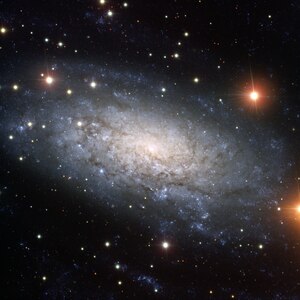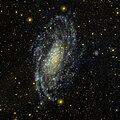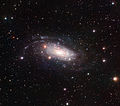NGC 3621
| Galaxy NGC 3621 |
|
|---|---|

|
|
| Image taken with the Very Large Telescope | |
| AladinLite | |
| Constellation | Water snake |
|
Position equinox : J2000.0 , epoch : J2000.0 |
|
| Right ascension | 11 h 18 m 16.5 s |
| declination | -32 ° 48 ′ 51 ″ |
| Appearance | |
| Morphological type | SA (s) d / HII |
| Brightness (visual) | 9.4 mag |
| Brightness (B-band) | 10.1 mag |
| Angular expansion | 12.3 ′ × 6.8 ′ |
| Position angle | 159 ° |
| Surface brightness | 14.1 mag / arcmin² |
| Physical data | |
| Redshift | 0.002435 ± 0.000007 |
| Radial velocity | 730 ± 2 km / s |
|
Stroke distance v rad / H 0 |
(24 ± 2) x 10 6 ly (7.26 ± 0.52) Mpc |
| history | |
| discovery | William Herschel |
| Discovery date | February 17, 1790 |
| Catalog names | |
| NGC 3621 • UGC UGCA 232 • PGC 34554 • ESO 377-37 • MCG -05-27-008 • IRAS 11159-3235 • 2MASX J11181630-3248453 • GC 2371 • H I 241 • h 3337 • AM 1115-323 • Dun 617 | |
NGC 3621 is a spiral galaxy of Hubble type SBCD in the constellation Hydra at the southern sky . The galaxy is estimated to be 24 million light years from the Milky Way and has a disk diameter of around 86,000 ly.
In contrast to most other spiral galaxies, the system does not have a central bulge , i.e. a spherical collection of old stars. The galaxy is therefore considered to be a pure disk galaxy, also known as a pure disc galaxy .
Nevertheless, there seems to be an active supermassive black hole in the center of NGC 3621 , which one would only expect in galaxies with such a bulge. However, this is relatively small and should not exceed a mass of around 20,000 solar masses . There are, however, and this is another special feature, two more black holes in the central region of the galaxy with a few thousand solar masses.
Numerous bright star formation areas with young bluish stars can be seen in the spiral arms . The arms are also streaked with thick clouds of dark dust .
The object was discovered by William Herschel on February 17, 1790 .
NGC 3621 in the infrared , imaged with the Spitzer Space Telescope
Receiving the ultraviolet radiation by GALEX
Mosaic of high-resolution images from the Hubble Space Telescope
Image taken with the Wide Field Imager (WFI) at the 2.2 m telescope La Silla Observatory
Web links
- SIMBAD Astronomical Database
- GoBlack
- Altilhue - Chile
- Capella Observatory
- NGC 3621: Far Beyond the Local Group - Astronomy Picture of the Day of June 5, 2002 (English).
- http://www.eso.org/public/usa/videos/eso1104a/ (zoom on NGC 3621)
- ESO: NGC 3621, a picturesque disk galaxy (+ photos, map & animation) February 2, 2011
- ESO: A galaxy full of surprises - NGC 3621 has no bulge, but three central black holes
- astronews.com: Picture of the day November 29, 2011
- astronews.com: Picture of the day October 14, 2013




